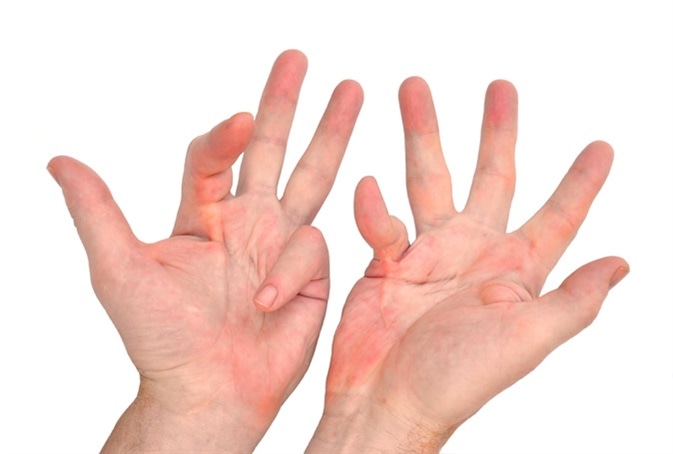Dupuytren's contracture is a condition that impacts the fingers and the hands, causing at least one finger, and possibly several, to bend toward the palm of the hand. Also known as Dupuytren's disease, the condition can affect both hands, including the thumbs.

Dupuytren's contracture. Image Credit: Sokolenok / Shutterstock
Dupuytren's contracture makes itself known with a thickening of the fibrous connective tissue in the palm of the hand. Initially, the tissue will become thick in a small area, forming a small nodule that lies beneath the skin. The nodule is often less than 1 cm in size and at first feels tender. Additional nodules may evolve. Most often, the condition affects the pinky and the ring finger, most often in the older male population of Northern European descent.
Dupuytren's contracture is not a life-threatening condition, and the nodules are not cancerous. However, what happens over time can be discomforting. Eventually, the lumps, or nodules, may grow into cords of cells or tissue. If these strings of tissue have grown along a finger or thumb, they may pull it and bend it toward the center or palm of a hand.
The lumps may decrease in size. This shortening of the tissue may begin as a mild event but may become more painful and difficult. For example, it is not possible to completely straighten the inflicted fingers. This makes it difficult to do such simple actions as placing one’s hands in one’s pockets or wearing gloves comfortably. Even the simplest handshake is challenging.
More Widespread than Thought
Dupuytren's contracture may be more common than thought. If reports of the condition are based on doctors’ records, then approximately 1% of the US population is affected. However, the condition may be under-reported. A 2010 web-based survey found that if incidents of the disease are based on a survey of patients, the affected population may reach more than 7%.
The personal survey revealed more than a review of physician charts would show. If a doctor is treating a health condition, then a record of the treatments will appear on a patient’s chart. So, if a patient is not undergoing a specific treatment for Dupuytren disease, the condition probably will not be noted on that person’s medical chart.
The survey also found that the condition is poorly diagnosed, or under-diagnosed. Fewer than 10% of patients receive a proper diagnosis of the disease upon their first doctor visit.
Additional data, and some interesting results, come from a 2014 study which combined information from several reports. The study shows that Dupuytren is 2.6 times twice as common in males as females generally. However, this statistic varies according to age. In people who are less than 50 years old, the condition is 10 times more common in males than in females. But for those who are 60 years or older, the disease is slightly more than twice as common in males as in females. Also, in those who are 85 years old and older, the condition is more common in females.
A Need for Biomarkers
Most of those with the condition do not have full contractures of the hand. About 15% do: 3 million of 20 million patients in the USA. Three-quarters of a million stand a good chance of being permanently crippled. Approximately 5% of patients have a version of the condition that is extremely aggressive and does not respond well to treatment.
Treatment and management of the condition would benefit from biomarkers that would predict the condition. The risk of progressing from a lump to a stage requiring treatment is in the range of 20% to 40% per decade.
Further Reading